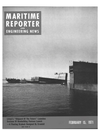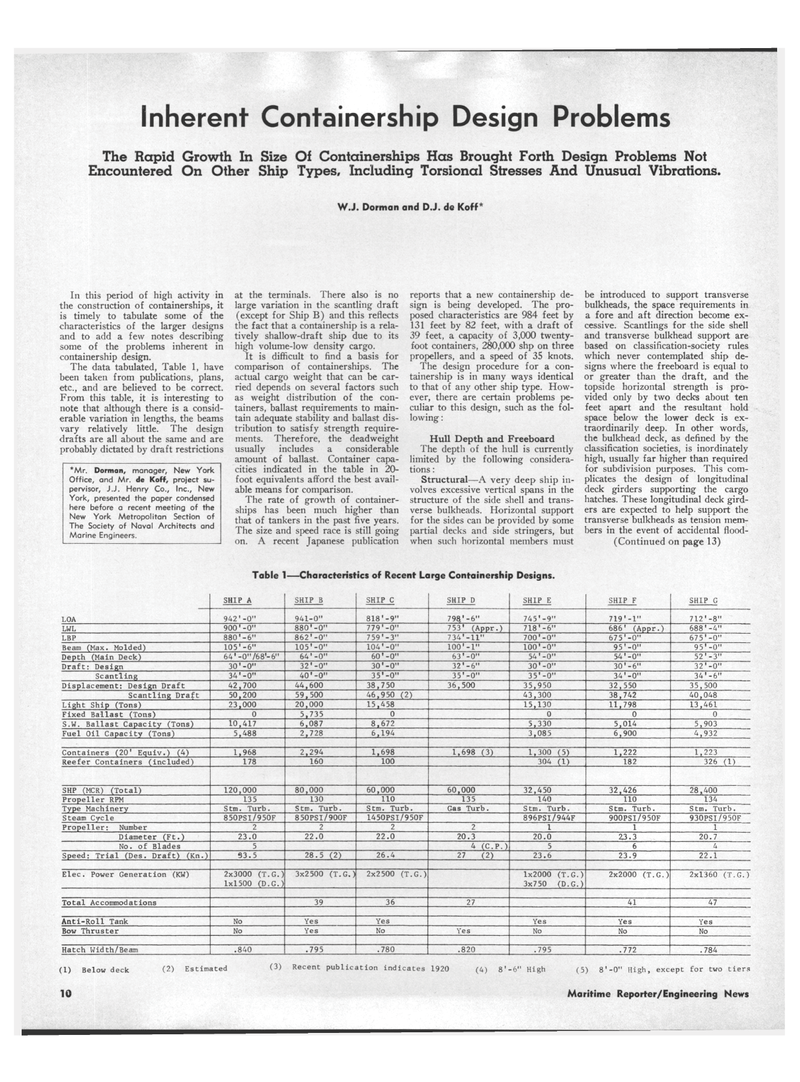
Page 8: of Maritime Reporter Magazine (February 15, 1971)
Read this page in Pdf, Flash or Html5 edition of February 15, 1971 Maritime Reporter Magazine
Inherent Containership Design Problems
The Rapid Growth In Size Of Containerships Has Brought Forth Design Problems Not
Encountered On Other Ship Types, Including Torsional Stresses And Unusual Vibrations.
W.J. Dorman and D.J. de Koff*
In this period of high activity in the construction of containerships, it is timely to tabulate some of the characteristics of the larger designs and to add a few notes describing some of the problems inherent in containership design.
The data tabulated, Table 1, have been taken from publications, plans, etc., and are believed to be correct.
From this table, it is interesting to note that although there is a consid- erable variation in lengths, the beams vary relatively little. The design drafts are all about the same and are probably dictated by draft restrictions *Mr. Dorman, manager. New York
Office, and Mr. de Koff, project su- pervisor, J.J. Henry Co., Inc., New
York, presented the paper condensed here before a recent meeting of the
New York Metropolitan Section of
The Society of Naval Architects and
Marine Engineers. at the terminals. There also is no large variation in the scantling draft (except for Ship B) and this reflects the fact that a containership is a rela- tively shallow-draft ship due to its high volume-low density cargo.
It is difficult to find a basis for comparison of containerships. The actual cargo weight that can be car- ried depends on several factors such as weight distribution of the con- tainers, ballast requirements to main- tain adequate stability and ballast dis- tribution to satisfy strength require- ments. Therefore, the deadweight usually includes a considerable amount of ballast. Container capa- cities indicated in the table in 20- foot equivalents afford the best avail- able means for comparison.
The rate of growth of container- ships has been much higher than that of tankers in the past five years.
The size and speed race is still going on. A recent Japanese publication reports that a new containership de- sign is being developed. The pro- posed characteristics are 984 feet by 131 feet by 82 feet, with a draft of 39 feet, a capacity of 3,000 twenty- foot containers, 280,000 shp on three propellers, and a speed of 35 knots.
The design procedure for a con- tainership is in many ways identical to that of any other ship type. How- ever, there are certain problems pe- culiar to this design, such as the fol- lowing :
Hull Depth and Freeboard
The depth of the hull is currently limited by the following considera- tions :
Structural—A very deep ship in- volves excessive vertical spans in the structure of the side shell and trans- verse bulkheads. Horizontal support for the sides can be provided by some partial decks and side stringers, but when such horizontal members must be introduced to support transverse bulkheads, the space requirements in a fore and aft direction become ex- cessive. Scantlings for the side shell and transverse bulkhead support are based on classification-society rules which never contemplated ship de- signs where the freeboard is equal to or greater than the draft, and the topside horizontal strength is pro- vided only by two decks about ten feet apart and the resultant hold space below the lower deck is ex- traordinarily deep. In other words, the bulkhead deck, as defined by the classification societies, is inordinately high, usually far higher than required for subdivision purposes. This com- plicates the design of longitudinal deck girders supporting the cargo hatches. These longitudinal deck gird- ers are expected to help support the transverse bulkheads as tension mem- bers in the event of accidental flood- continued on page 13)
Table 1—Characteristics of Recent Large Containership Designs.
SHIP A SHIP B SHIP C SHIP D SHIP E SHIP F SHIP G
LOA 942'-0" 941-0" 818'-9" 79§'-6" 745'-9" 719'-1" 712'-8"
LWL 900'-0" 880*-0" 779'-0" 753' (Appr.) 718'-6" 686' (Appr.) 688'-4"
LBP 880'-6" 862'-0" 759'-3" 734'-11" 700'-0" 675'-0" 6751-0"
Beam (Max. Molded) 105'-6" 105'-0" 104'-0" lOO'-l" 100'-0" 95'-0" 951-0"
Depth (Main Deck) 64' -0"/68'-6" 64'-0" 60'-0" 63'-0" 54'-0" 54'-0" 52'-3"
Draft: Design 30'-0" 32'-0" 30'-0" 32'-6" 30 1-0" 30'-6" 32'-0"
Scantling 34*-0" 40"-0" 35'-0" 35'-0" 35'-0" 34'-0" 34'-6"
Displacement: Design Draft 42,700 44,600 38,750 36,500 35,950 32,550 35,500
Scantling Draft 50,200 59,500 46,950 ( 2) 43,300 38,742 40,048
Light Ship (Tons) 23,000 20,000 15,458 15,130 11,798 13,461
Fixed Ballast (Tons) 0 5,735 0 0 0 0
S.W. Ballast Capacity (Tons) 10,417 6,087 8,672 5,330 5,014 5,903
Fuel Oil Capacity (Tons) 5,488 2,728 6,194 3,085 6,900 4,932
Containers (20' Equiv.) (4) 1,968 2,294 1,698 1,698 (3) 1,300 (5) 1,222 1,223
Reefer Containers (included) 178 160 100 304 (1) 182 326 (1)
SHP (MCR) (Total) 120,000 80,000 60,000 60,000 32,450 32,426 28,400
Propeller RPM 135 130 110 135 140 110 134
Type Machinery Stm. Turb. Stm. Turb. Stm. Turb. Gas Turb. Stm. Turb. Stm. Turb. Stm. Turb.
Steam Cycle 850PSI/950F 850PSI/900F 1450PSI/950F 896PSI/944F 900PSI/950F 930PSI/950F
Propeller: Number 2 2 2 2 1 1 1
Diameter (Ft.) 23.0 22.0 22.0 20.3 20.0 23.3 20.7
No. of Blades 5 4 (C.P.) 5 6 4
Speed: Trial (Des. Draft) (Kn.) 93.5 28.5 (2) 26.4 27 (2) 23.6 23.9 22.1
Elec. Power Generation (KW) 2x3000 (T.G.) 1x1500 (D.G.) 3x2500 (T.G.) 2x2500 (T.G.) 1x2000 (T.G.) 3x750 (D.G.) 2x2000 (T.G.) 2x1360 (T.G.)
Total Accommodations 39 36 27 41 47
Anti-Roll Tank No Yes Yes Yes Yes Yes
Bow Thruster No Yes No Yes No No No
Hatch Width/Beam .840 .795 .780 .820 .795 .772 .784 (1) Below deck 10 (2) Estimated (3) Recent publication indicates 1920 (4) 8'-6" High (5) 8'-0" High, except for two tiers 10 Maritime Reporter/Engineering News

 7
7

 9
9
